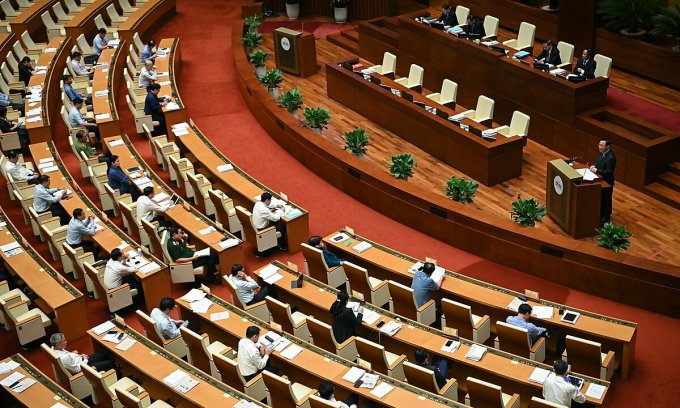Schedule for submission of financial statements as per Vietnamese law

Every year at a certain period, the accountants of the business will have to submit tax returns, financial statements or tax reports according to regulations. However, at present, many legal documents such as circulars and tax documents change constantly, which leads to mistakes and omissions when declaring taxes. So Through the following article, Lawyer X will share with readers the article: Schedule for submission of financial statements as per Vietnamese law
Legal grounds
- Accounting Law 2015
- Circular 200/2018/TT-BTC
- Circular 133/2016/TT-BTC
Regulations on financial reporting
According to Clause 1, Article 3 of the 2015 accounting law, financial statement is an economic and financial information system of an accounting unit presented according to the form specified in accounting standards and accounting regime. maths.
Financial statements apply to all types of enterprises established and operating under Vietnamese law. Enterprises are obliged to prepare and submit truthful, accurate and timely financial statements in accordance with the law on accounting and statistics.
Principles of preparing financial statements when changing accounting currency
When changing the accounting currency, at the first period since the change, the accountant converts the balance of the accounting book into the new accounting currency at the transfer rate of a commercial bank. where the enterprise regularly conducts transactions at the date of the change in the accounting currency.
Exchange rate applied to comparative information (prior period column) on the income statement and the statement of cash flows:
When presenting comparative information on the statement of income and the statement of cash flows of the period in which there is a change in the accounting currency, the entity shall apply the average transfer rate of the preceding period. adjacent to the period of change (if the average exchange rate is approximately the actual rate).
When changing the accounting currency, the enterprise must clearly state in the Notes to the Financial Statements the reason for the change in the accounting currency and the effects (if any) on the financial statements. due to a change in the accounting currency.
Subjects of preparation of annual financial statements:
The annual financial statement system is applicable to all types of enterprises in all sectors and economic sectors. The annual financial statements must be prepared in full format.
Steps to prepare financial statements
To make financial statements accurate and simple, you and your business can follow the following steps:
Step 1: Arrange the accounting documents
To be able to prepare financial statements, accountants need to arrange carefully and detailed accounting documents in the correct chronological order. This makes checking, declaring and reporting more convenient and easier.
Step 2: Make detailed accounting of arising economic transactions
Based on carefully arranged accounting vouchers, corporate accountants need to check and complete the vouchers to ensure the reasonableness, validity and legality in accordance with the law on accounting and tax.
Step 3: Categorize arising transactions by month, quarter
In order to be able to declare the standard annual financial statements, before that, corporate accountants also need to clearly classify arising transactions such as classification of prepaid expenses, depreciation expenses, etc.
Step 4: Review and summarize arising transactions by account group
This is a very important step to compile declaration information quickly and accurately. Accordingly, accountants can review the following groups of accounts:
– Check inventory group: It is necessary to check whether the inventory is negative or not. In the negative case, accountants need to find out the cause and adjust it to be reasonable and accurate. Applying the cost of goods sold according to the registered inventory method.
– Reviewing the group of receivables and payables: Corporate accountants need to compare with customers through the year-end debt reconciliation minutes and then review and check the arising of the creditor and the debtor to be able to accurately reflect the operations, calculate the risks of debts as well as tax liabilities that may be encountered.
– Reviewing investments: Corporate accountants need to re-check investment records, analyze clearly the nature and accounting methods, and then balance documents to record investment, accurately reflect investment efficiency. approve the minutes of the meeting and the documents and financial statements provided by the investee.
– Review prepaid expenses: Accountants need to check prepaid expenses to see if the declaration reflects reality or not.
– Reviewing fixed assets: Accountants need to check and calculate the original cost, useful life, principles of recording and allocating depreciation in accordance with the provisions of Circular No. 45/2013/TT-BTC, Circular No. 45/2013/TT-BTC, Circular No. Circular No. 28/2017/TT-BTC. In addition, when reviewing fixed assets, accountants should also note the provisions of Circular No. 151/2014/TT-BTC on the principle of VAT deduction and non-deductible expenses for CIT calculation for automobiles. passenger cars with 9 seats or less.
– Review of Revenue: Accountants check whether the revenue of each product has been reflected at the market price, the fluctuation of the selling price and the causes of the fluctuation to make appropriate regulations
– Reviewing cost of goods: Accountants need to check and ensure that the cost of each code of goods and services is accurately reflected, and the accuracy is reflected in gross profit.
– Review of administrative costs: Accountants check and ensure the reasonableness of records, the ratio of expenses to revenue, accounts, and expense recognition are reflected in accordance with reality and in accordance with principles. accountant.
Note that, in case an error is detected, accountants need to find out the cause and correct it immediately to ensure accuracy when declaring financial statements.
Step 5: Perform summary and transfer entries
After carefully reviewing the necessary data, the accountant will conduct the entry of revenue, expenses, profit and loss, and ensure that the accounts from the beginning of the 5th to the beginning of 9 have no ending balance. period.
Step 6: Prepare financial statements
After reviewing and synthesizing all necessary data, the corporate accountant will make annual financial statements on HTKK software to complete the financial statement declaration.
Accordingly, the preparation of financial statements is carried out in the following order:
– The accountant opens the HTKK software installed on the computer and then logs in with his business account.
Schedule for submission of annual financial statements as prescribed by law
Pursuant to Article 109, Circular 200/2014/TT-BTC, the deadline for submitting financial statements is as follows:
For state-owned enterprises
Quarterly financial report
Accounting units: Submit quarterly financial statements within 20 days from the end of the quarterly accounting period.
Parent company, State corporation: Submit financial statements no later than 45 days from the end of the quarterly accounting period.
Accounting units affiliated to enterprises, State Corporations: The time limit for submitting financial statements is prescribed by the parent company and the Corporation.
Annual financial reports
Accounting units: Submit quarterly financial statements within 30 days from the end of the annual accounting period.
Parent company, State corporation: Submit financial statements no later than 90 days from the end of the annual accounting period.
Accounting units affiliated to enterprises, State Corporations: The time limit for submitting financial statements is prescribed by the parent company and the Corporation.
Related articles:
- Procedures for applying for a license for a financial company in Vietnam
- Penalty for late submission of financial statements in Vietnam
- Establishing a financial company in Vietnam
Services of LawyerX
Prestigious professional services: Firstly, the team of consultants and consultants for many years in the field of civil status, and customer support.
On-time: Certainly, with the motto “Get your lawyer right at your fingertips”, we ensure the service always performs on time. The rights and interests of customers always come first.
Cost: Besides, Lawyer X’s service costs are highly competitive; depending on the nature of the particular case. So, we want our guests to have the best possible service experience. Therefore, costs which guaranteed to be the most suitable and economical for customers.
Confidentiality of client information: Finally, all brand information of client Lawyer X will be 100% confidential.
Please contact us immediately if you have any questions about “Schedule for submission of financial statements as per Vietnamese law”
Contact LSX Lawfirm
Finally, we hope this article is useful for you to answer the question about: “Schedule for submission of financial statements as per Vietnamese law”. If you need any further information, please contact LSX Law firm: +84846175333 or Email: [email protected]
Frequently asked questions
Pursuant to Clause 3, Article 29 of the 2015 accounting law, the annual financial statements of an accounting unit must be submitted to a competent state agency within 90 days from the end of the annual accounting period according to regulations. provisions of the law
According to Circular 200, which is stipulated in Article 100, financial statements for enterprises include:
Accounting balance sheet (Form B01-DN
Report on business results (Form B02-DN)
Statement of cash flows (Form B03-DN)
Note to financial statement (Form B09-DN)
The full interim financial statements will include:
Balance sheet on interim accounting (Form B01a-DN).
Report on results of interim business activities (Form No. B02a- DN).
BC for interim cash flows (Form B03a-DN).
Notes to selected financial position statement (Form B09a-DN
What does the set of financial statements include according to Circular 133?
Financial status report.
Balance sheet account.
Statements of cash flows.
BC results of production and business activities.
Notes to the financial statements.
Conclusion: So the above is Schedule for submission of financial statements as per Vietnamese law. Hopefully with this article can help you in life, please always follow and read our good articles on the website: lsxlawfirm.com




